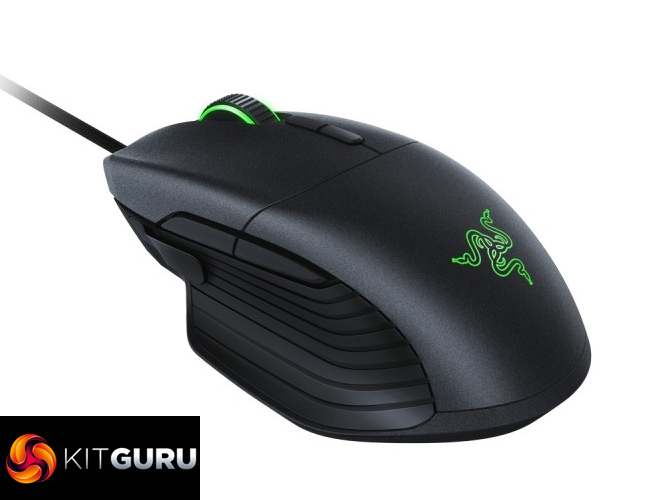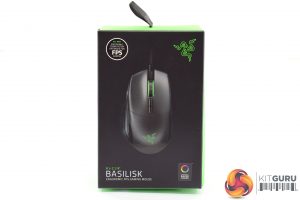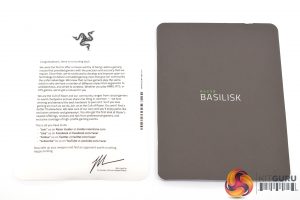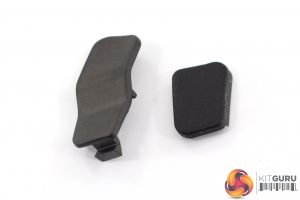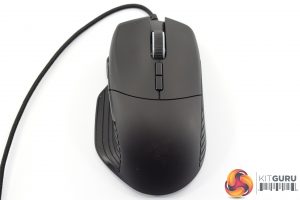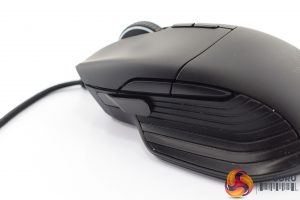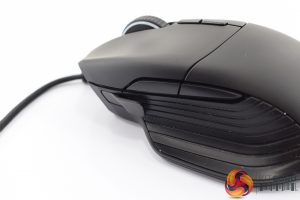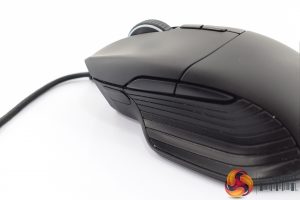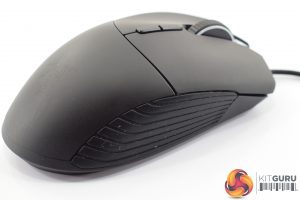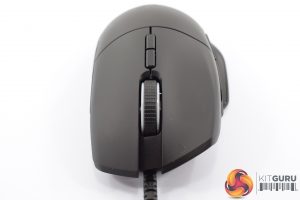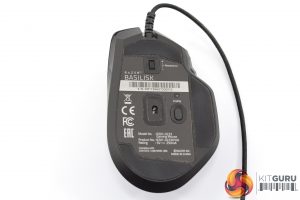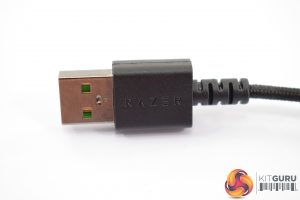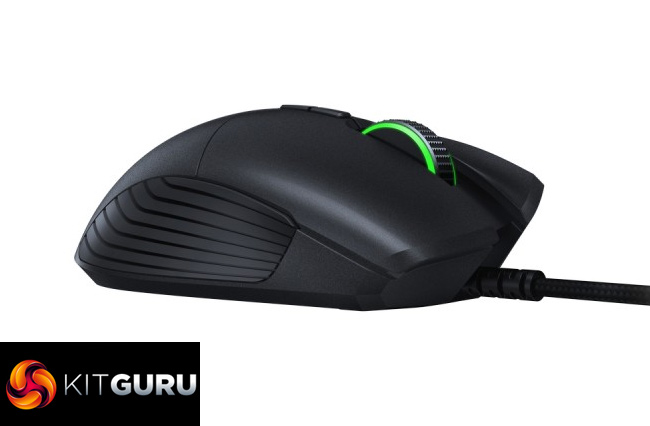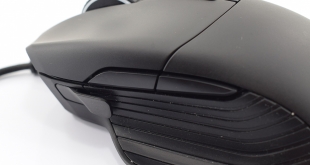
Having previously given Razer's DeathAdder Elite KitGuru's ‘Must Have' award, you can bet I was excited to get hands-on with the company's latest mouse – the Basilisk. The Basilisk is an entirely different beast to the DeathAdder, however – and please excuse the pun. With a new, ergonomic shape, a replaceable DPI clutch as well as adjustable scroll wheel tension settings, could this be your ultimate gaming mouse?
As befits the latest mouse from Razer, the Basilisk oozes class and style – and you can bet that it supports Chroma RGB lighting. However, looks aren't everything, especially not with something as personal as a mouse. Can the Basilisk match the standard set by the DeathAdder Elite, or is it destined to fall short? Let's find out.
Specification
- Razer 5G optical sensor with true 16,000 DPI
- Up to 450 inches per second (IPS) / 50 G acceleration
- Razer™ Mechanical Mouse Switches
- Eight independently programmable Hyperesponse buttons
- Gaming-grade tactile scroll wheel with customizable resistance
- Ergonomic right-handed design with enhanced rubber side grips
- Razer Chroma™ lighting with true 16.8 million customizable color options
- 1000 Hz Ultrapolling
- Razer Synapse 3 (Beta) enabled
- Approximate size: 124 mm / 4.88 in (Length) X 75 mm / 2.94 in (Width) X 43 mm / 1.69 in (Height)
- Approximate weight 107 g / 0.24 lbs (Excluding cable)
If you have bought any Razer product over the last few years, you will instantly recognise the box that the Basilisk ships in – it is black with green accents, and a large product photo dominates the front.
Inside, a Razer greeting card is included, as well as a quick-start guide.
There are also a couple of tiny little attachments included in the box – these are for the Basilisk's replaceable DPI clutch, something we will touch on below.
Now, the mouse itself is on the larger side, measuring 124 mm x 75 mm x 43 mm, but it is not gigantic. There is a thumb-rest integrated into the left-hand side of the mouse, giving it a more ergonomic design when compared to the DeathAdder Elite.
It is heavier than the DeathAdder Elite (DAE), too, but the difference is small – at 107g, the Basilisk is just 2g heavier. Hardly major, but worth noting.
On the left-hand side of the mouse we find two side buttons, as well as the DPI clutch. If you're wondering, ‘DPI clutch' is Razer's way of saying ‘sniper button' – pressing the clutch lowers the mouse's DPI setting for as long as the clutch is held.
What makes it interesting, however, is the fact that the clutch is removable. By default, a longer clutch ‘paddle' is installed, while a smaller one is also included in the box. You can see both installed in the images above.
If you're not keen on the idea, Razer also includes a small rubber blanking plate which just covers the button to prevent any unwanted presses.
Moving over to the right-hand side of the mouse, there are no buttons here, though most of the side is covered with textured rubber.
At the front of the mouse, we find the textured scroll wheel, while two DPI buttons sit just below that. The LMB and RMB buttons themselves are entirely separate from the main body of the mouse, too, which should make it easier to trigger the clicks, no matter where you press.
On the underside of the mouse, there are a couple of things to note. First of all, right at the top, there is actually a small scroll wheel resistance dial which lets you tune the scroll wheel's resistance to your liking. Next to the sensor, there is another small button labelled ‘profile'. This lets you change between 4 different profiles which can be stored to the mouse's internal memory, removing the need for software.
Lastly, the mouse connects via an integrated USB cable. Measuring 2m long, it also braided and is very flexible.To test the Basilisk, I used it as my daily driver for two weeks. During this time, I played games, edited photos and used it for general office duties as well.
Software
Note: If the gallery above is not displaying properly, please disable AdBlock as it is known to interfere with our display code.
Starting off with the software aspect of the mouse, the Basilisk supports Synapse 3. This software is still in beta, and only supports certain Razer products, but it is pretty fleshed-out and worked well for me while I was using the Basilisk.
Broadly speaking, it does seem to be very similar to Synapse 2, but with a more modern UI. There are a few new features to mention, though. Starting with HyperShift, this is very similar to Roccat's EasyShift [+] technology – essentially, users programme one of the mouse's 9 programmable buttons to act as a modifier button, and then an extra layer of secondary functions can be applied to each button. It is a nifty way to essentially double the amount of functions that can be mapped to the mouse.
Other than that, the Chroma studio is also worth touching on. This is for those who are not content with the preset lighting options and want to create their own effects. You can stack different effects on top of each other, choose different speeds and customise the scroll wheel and Razer logo zones separately. It's a neat way to get more customisation out of the mouse's lighting.
However, my biggest issue with Synapse 3 is that is does not support quite a few of Razer's other products. For example, I am currently using a BlackWidow Chroma V2 TE keyboard as my daily driver, and the keyboard only works with Synapse 2. This means I have to have both programs installed on my computer, and it also means I cannot synchronise the lighting between the two products. Considering Razer's Chroma ecosystem is a fairly significant feature of their modern peripherals, that is quite disappointing. Eventually Synapse 3 will support Razer's other peripherals, but for now I do find it frustrating that the company is designing certain products to work with the software, while other products have to rely on an older version of Synapse.
Lighting
Note: If the gallery above is not displaying properly, please disable AdBlock as it is known to interfere with our display code.
Moving onto the Basilisk's lighting, the overall effect is very similar to that of the DeathAdder Elite. That's quite a good thing, though, as the colours are bright, vibrant and also very accurate. However, I would've liked to see a bit more innovation with the lighting – aside from the ability to customise the lighting effects, it doesn't feel very special. Perhaps an LED strip down the side might add a bit more interest, but overall there is nothing we haven't seen before when it comes to the Basilisk's RGB lighting.
Comfort and performance
Now, let's move onto physically using the mouse.
Starting with comfort, I can say I immediately appreciated the large thumb-rest on the left-hand side of the mouse. It is perfectly positioned (for my hand, at least) and provides that bit of extra support you don't get from the DAE. With my preferred claw-grip, my index and middle fingers also sat perfectly aligned with the LMB and RMB buttons, while the curve of the Basilisk fits right into my palm.
However, what lets the Basilisk down in terms of its design is the right-hand side. I can appreciate comfort is a very subjective area, but for me, the right-hand side of the mouse slopes down far too steeply, and that leaves my fourth and pinky fingers resting almost entirely on my mouse pad. This is not a problem when gaming for an hour or two, but I sit at my desk all day – after several hours, my fingers do feel a bit rough from being dragged against the mouse pad the whole time.
If the right-hand side was less flat I think this problem would be solved. However, as it is, the Basilisk doesn't quite tick all of my boxes in terms of comfort.
Another subjective area, but potentially a problematic one, is mouse weight. At 107g (not including cable) the Basilisk is a fair bit heavier than other FPS mice like the HyperX Pulsefire or SteelSeries Rival 310. For me, it did take a bit of getting used to, but I am not too fussy about the weight of my mouse. Some gamers are, though, and I can imagine 107g being too much for plenty of people out there.
Moving on, the Basilisk's DPI clutch is also worth touching on, and I think the implementation of this idea is brilliantly done. There's no denying a sniper button is a useful feature, but usually such buttons are placed right in the middle of the mouse's side – as per the ASUS ROG Gladius II and the Corsair M65 Pro – and they can easily get in the way. Razer's solution is to have the button at the top end of the mouse, but to have it triggered by a small clutch/paddle.
Two different sizes of paddle are included – the one installed by default is longer, and I found my thumb would rest against it all the time, causing accidental presses. The shorter paddle is perfect, though – it is within easy reach of my thumb, but I won't accidentally press it at a crucial moment. It's quite a simple idea really, but it is done very well.
Other than that, having adjustable scroll wheel resistance is another interesting idea. In practice, you will likely set it once and not touch it again, but it does allow each user to get the settings just right for them, giving the Basilisk a more personal feel than something that is completely off-the-shelf. For reference, at its ‘loosest', the wheel is very fast, with no distinct steps – very similar to Logitech's Infinite Scroll. At the tightest setting, each step is very noticeable and you won't accidentally scroll if you don't want to. Most people will probably find their ideal setting somewhere in between the two.
In terms of actual sensor performance, Razer's optical 5G sensor is as good as ever – I can't say I noticed any difference in tracking or response times between the Basilisk and the DAE, and that is certainly a very good thing. In short, I has no issues with the sensor.
Lastly, the RMB and LMB switches are worth discussing. Coming directly from the HyperX Pulsefire I did find the clicks to be a bit heavier and more tactile – the Pulsefire's switches are just a little bit lighter and faster. However, that's not to say one is better than the other as a lot of it is personal preference. Speaking for myself, though, the Basilisk does feel very satisfying to click with.A new mouse from Razer, the Basilisk is certainly impressive, though it is not quite perfect.
Starting off with its design, on one hand I really appreciate the new thumb rest – it adds a vital bit of support which is lacking from the DeathAdder Elite, so its inclusion can only be positive.
However, the ergonomics are let down by the right-hand side of the mouse. Simply put, that side slopes away far too steeply, leaving my fourth and pinky fingers resting almost entirely on my mouse pad. After a while, that does get uncomfortable.
The Basilisk does have some new features, though, with its DPI clutch being a big improvement on the sniper buttons we are used to seeing. The scroll wheel's adjustable resistance also adds an opportunity for end-users to tailor the mouse exactly how they want it. If we add in the flawless performance of the optical 5G sensor, as well as the strong, tactile switches, the Basilisk is definitely a solid overall package.
Users are let down by Razer's current software situation, however. At the minute, there are two versions of Synapse available, and they are not cross-compatible – I needed Synapse 2 for my keyboard and Synapse 3 for the mouse, for example. This also means that the Chroma lighting cannot be synchronised across both devices, and that is a big selling point for buying into Razer's peripheral ecosystem. I really think Razer should've got support for all its peripherals on Synapse 3 before releasing it, as now we are stuck in a kind of limbo waiting for everything to be supported on the new software.
As such, we can't quite give the Razer Basilisk our ‘Must Have' award – its ergonomics, coupled with the current software situation, hold it back. It is, however, an overall good buy, particularly if you know the ergonomics won't be an issue for you. Speaking for myself, though, I'll be sticking with the DeathAdder Elite.
You can buy one from Overclockers UK for £59.99 HERE.
DIscuss on our Facebook page, over HERE.
Pros
- Thumb rest is a good addition.
- DPI clutch is much more convenient than a standard sniper button.
- Adjustable scroll wheel.
- Flawless performance.
Cons
- Ergonomics are let down by the flat right-hand side.
- Software support for Razer products is currently split between two versions of Synapse, which is not only a bit confusing but means Chroma sync won't work across all devices.
KitGuru says: The Basilisk is certainly a good mouse with a couple of new features which help it stand out. However, I do think the ergonomics need tweaking, while the software situation doesn't help matters either.
Be sure to check out our sponsors store EKWB here
 KitGuru KitGuru.net – Tech News | Hardware News | Hardware Reviews | IOS | Mobile | Gaming | Graphics Cards
KitGuru KitGuru.net – Tech News | Hardware News | Hardware Reviews | IOS | Mobile | Gaming | Graphics Cards


